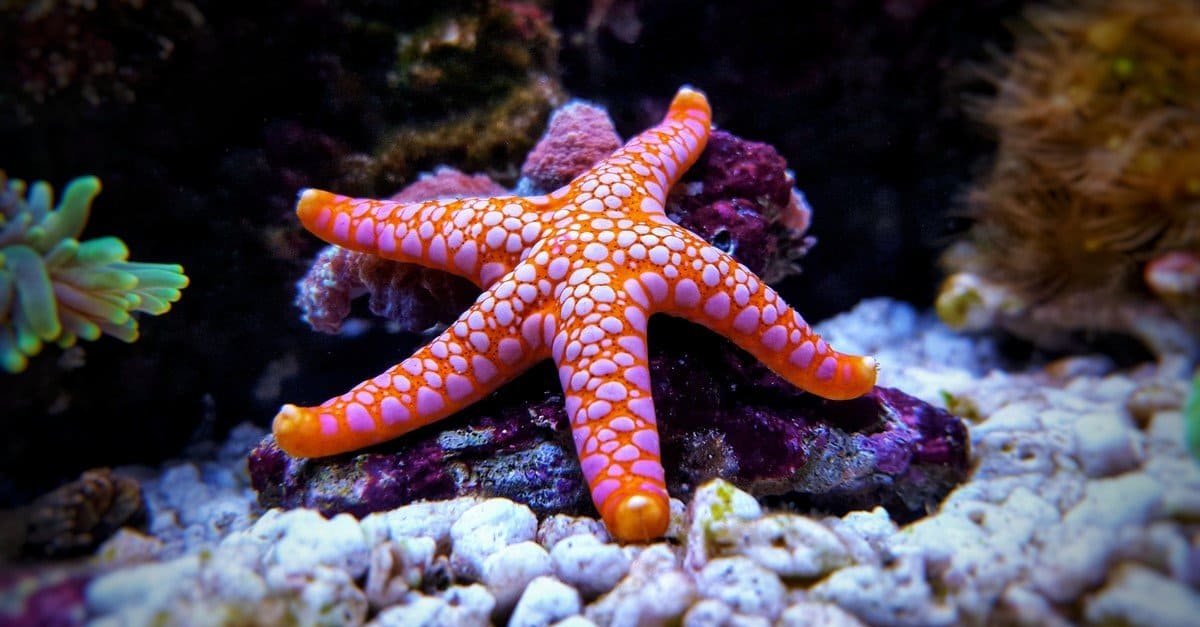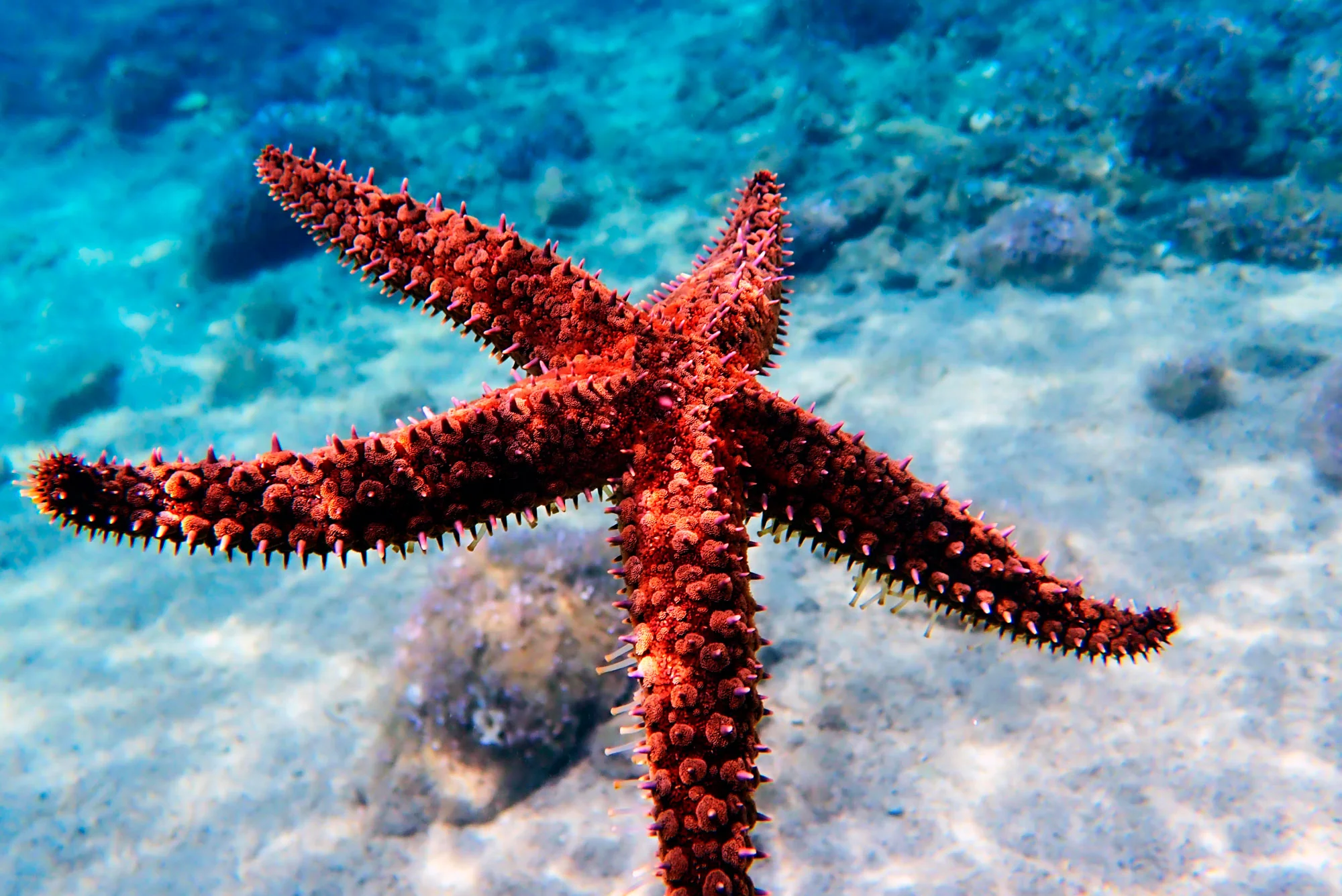Starfish are predators that regulate populations of shellfish and other invertebrates, aiding in nutrient cycling and decomposition.
Starfish play a crucial and underappreciated role in marine ecosystems around the world.
This article will explore the environmental benefits of starfish and the threats they currently face from climate change and disease.
What Do Starfish Do for the Environment?
Starfish are crucial predators and scavengers that regulate populations, facilitate nutrient cycling, and promote overall balance in marine ecosystems where they reside.
Their presence and abundance serve as an indicator of ecosystem health.
Key Points
- Starfish prey on shellfish and invertebrates, controlling their numbers as keystone predators.
- They feed on decaying organic matter, allowing nutrients to be recycled back into the food chain.
- Healthy starfish populations signify a balanced and biodiverse marine habitat.
What Are Some Distinguishing Traits of Starfish?
Starfish, also known as sea stars, are easily recognized by their star shape and multiple arms.
There are over 2,000 species worldwide found in intertidal zones, coral reefs, sandy or muddy bottoms, and deep waters.
Their surface is covered in hard, bumpy skin and they move using hundreds of tiny tube feet underneath.
Amazingly, starfish don’t have blood, brains, or hearts.
Instead, they circulate nutrients through their water vascular system using filtered seawater.
This is how they can survive underwater.
Starfish also have eyespots on the ends of their arms to detect light and an amazing ability to regenerate lost limbs.
How Do Starfish Hunt for Food?
Starfish are expert hunters, preying on bivalves like mussels and clams, as well as snails, barnacles, and even small fish.
Using their powerful tube feet, starfish pry open clam and mussel shells.
They extend their stomach out of their mouth and into the bivalve’s shell to digest its flesh.
Starfish move slowly but deliberately, gliding along the seafloor or coral reef in search of prey.
Once they detect chemical cues from potential food using sensory organs on their arms, they commence feeding using their uncanny ability to force open shells.
Why Are Starfish Important for the Environment?
As predators, starfish play a crucial regulatory role in ocean ecosystems.
They help keep populations of filter-feeding shellfish under control.
Without starfish predation, mussels, and clams could easily overpopulate an area, displacing other species.
Starfish are also important for cycling nutrients in food chains and facilitating the decomposition process.
By feeding on dead and decaying matter, starfish allow nutrients like carbon and nitrogen to be recycled back into the marine ecosystem.
Overall, starfish fill an important niche in their native habitats.
The presence of healthy starfish populations is a good indicator of balance in marine ecosystems.
That’s why starfish are considered a keystone species.
How Does Climate Change Affect Starfish?
Starfish are particularly vulnerable to disturbances associated with climate change.
Ocean warming and acidification can damage and degrade important marine habitats like coral reefs where starfish live.
Loss of coral reefs eliminates crucial nursery habitat for young starfish.
Reef deterioration also reduces the availability of prey like oysters, clams, and mussels.
This food scarcity makes it harder for starfish populations to thrive.
In addition, starfish suffer direct impacts from elevated temperatures.
Overheating causes severe stress, making starfish more prone to disease and mass mortality events.
What is Sea Star Wasting Disease?
Sea star wasting disease is a deadly condition that emerged in 2013 causing massive starfish die-offs along the Pacific coast.
The disease leads to tissue decay, lesions, loss of limbs, and eventual death by disintegration.
Scientists believe warmer waters are responsible for the spread of sea star wasting syndrome.
Elevated temperatures enable pathogens to proliferate rapidly.
Sadly, some species like the sunflower star have been decimated by this gruesome disease.
How Can We Protect Starfish Populations?
More research and active intervention are needed to protect starfish from warming oceans and wasting disease.
Creating more marine protected areas could safeguard habitats and food sources.
Citizen science programs also enable people to report sightings and disease outbreaks.
Aquariums are investigating captive breeding as an emergency measure to prevent extinctions.
We all depend on healthy oceans.
Since starfish are key species with an outsized ecological role, their conservation should be an urgent priority.
Why Does the Loss of Starfish Matter?
Starfish support marine food webs and protect biodiversity.
Their disappearance would have far-reaching consequences across ecosystems.
Mussels, clams, and other invertebrates could explode in population, overwhelming their habitats.
Declining starfish would also indicate broader issues like climate change, pollution, and habitat degradation.
The plight of starfish highlights the need for sustainability reforms and policies that safeguard all marine life.
Losing these iconic ocean dwellers would represent a failure to adequately protect the living world.
That’s why preserving starfish populations should matter to all of us.
What Would Happen If Starfish Are Removed?
If starfish were removed from an ecosystem, there would be significant disruptions up and down the food chain.
Without starfish preying on shellfish like clams, mussels, and oysters, their populations could explode unchecked.
This would allow filter feeders to dominate seafloor habitats, radically changing the balance of species.
Additionally, the loss of starfish would impact nutrient cycling.
With fewer starfish eating and digesting waste and debris, the process of decomposition would slow.
Dead plant and animal matter would accumulate, decreasing water quality and oxygen levels.
Important nutrients like nitrogen and carbon would not be released back into the marine ecosystem as efficiently.
Overall, the disappearance of starfish would reverberate across coastal habitats and have long-term detrimental effects on biodiversity.
That’s why marine biologists consider them a keystone species – their presence is vital for maintaining healthy marine communities.
How Do Starfish Interact with Their Environment?
Starfish interact with their marine environments in several important ways.
As predators, they help regulate the populations of shellfish, snails, and other invertebrates that share their ecosystem.
Starfish use their senses to detect prey, pry open shells with their tube feet, and extrude their stomachs to digest food.
As scavengers, starfish play a role in decomposition by consuming dead plant and animal material.
This facilitates nutrient cycling and allows key compounds like nitrogen and carbon to be released back into the marine food web.
Starfish also compete with other species for food sources and habitat.
They require healthy ecosystems with ample prey availability and suitable places to shelter.
Therefore, starfish populations serve as an indicator of the overall state of marine environments.
Finally, starfish themselves are prey for other species.
As both predator and prey, starfish are an integral part of complex marine food chains.
Their interactions form a web of energy flow throughout ocean ecosystems.
What Do Starfish Do To Humans?
For the most part, starfish do not pose any direct threat to humans.
There are no reports of starfish attacking, preying on, or aggressively competing with people.
However, starfish can have minor impacts on human activities in coastal zones.
As predators, starfish can affect shellfish aquaculture operations.
Large numbers of starfish may infest cultivated mussel or oyster beds and cause economic damage.
However, starfish tend to prey on wild, not farmed shellfish.
The spines on some starfish can deliver a painful sting if stepped on by accident.
But stings are generally not life-threatening to humans.
Certain species have toxins in their tissues that can cause sickness if eaten.
Overall, starfish are not malicious organisms.
While they may hinder some fishing or harvesting, they benefit humans more broadly by supporting marine biodiversity and ecosystem health through their role as keystone predators.
Key Takeaways
Starfish or sea stars play several important roles in their ocean environments.
They control populations of shellfish and invertebrates as predators, facilitate nutrient cycling by feeding on decaying organic matter, and serve as indicators of overall ecosystem health.
However, starfish now face major threats from climate change, most notably warming oceans and sea star wasting disease.
Conserving these keystone species through marine protected areas and other conservation efforts is critical for maintaining balance and biodiversity in ocean habitats.
The decline of starfish would have disastrous impacts on marine food chains.
Frequently Asked Questions
How Many Arms Do Starfish Have?
Starfish generally have 5 arms, but some species can have up to 40 arms. The arms extend from their central disk where their mouth is located.
What Eats Starfish?
Some predators of starfish include sea otters, fish, crabs, seabirds, and other starfish. Their hard external skeleton and ability to regenerate lost limbs help protect them from predators.
How Do Starfish Reproduce?
Most starfish reproduce sexually by releasing eggs and sperm into the water column. Fertilized eggs develop into larvae before settling on the seafloor and growing into juvenile starfish.
Why Are Starfish Important?
Starfish are ecologically important for their roles as keystone predators and scavengers. They help regulate marine food webs and recycle nutrients through the ecosystem.
How Long Can Starfish Live?
The life span of a starfish depends on the species but generally ranges from 10 to 35 years in the wild. Some species have been known to live for up to 50 years.
The writers at GreenChiCafe are passionate about the environment and the extraordinary biodiversity of our natural world. We love sharing fascinating facts about keystone species like starfish and spreading awareness about conservation. Be sure to check out GreenChiCafe.com for more engaging content that explores the wonders of nature!

Annie is a passionate environmental writer and activist. She has been writing about sustainability, conservation, and green living for over 15+ years. Annie is dedicated to raising awareness about environmental issues and providing practical tips for living an eco-friendly lifestyle. When she’s not writing, you can find her volunteering with local environmental organizations, teaching workshops on zero waste living, or exploring nature. Feel free to get in touch with Annie: annie@greenchicafe.com


